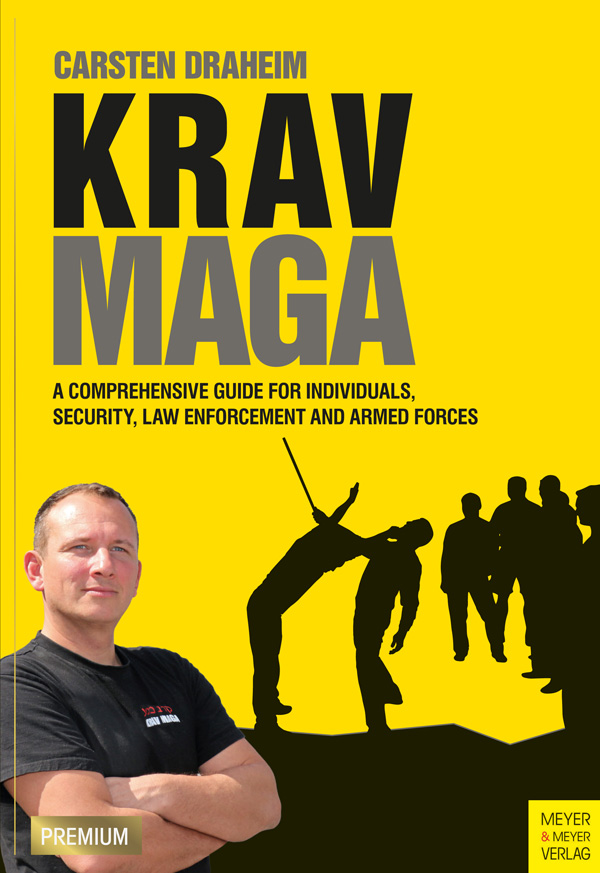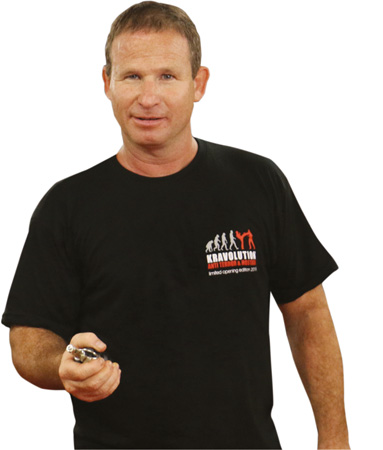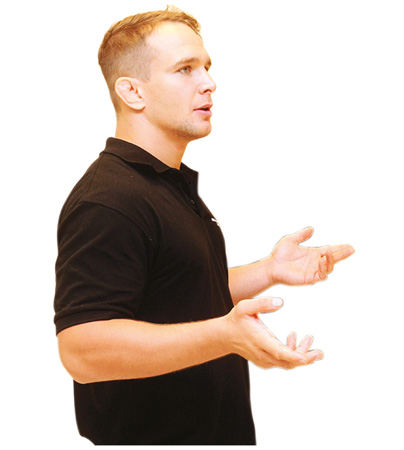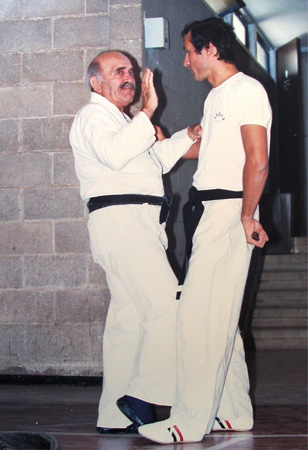

Carsten Draheim
Krav Maga
A Comprehensive Guide for Individuals, Security, Law Enforcement and Armed Forces
Meyer & Meyer Sport (UK) Ltd.

Original title: Krav Maga. Effektive Selbstverteidigung, Meyer & Meyer, Aachen, 2015
Translated by: AAA Translation, St. Louis, Missouri
British Library Cataloguing in Publication Data
A Catalogue record for this book is available from the British Library
Krav Maga
Maidenhead: Meyer & Meyer Sport (UK) Ltd., 2017
All rights reserved, especially the right to copy and distribute, including the translation rights. No part of this work may be reproduced -including by photo copy, microfilm, or any other means- processed, stored electronically, copied or distributed in any form whatsoever without the written permission of the publisher.
© 2017 by Meyer & Meyer Sport (UK) Ltd.
Auckland, Beirut, Dubai, Hägendorf, Hong Kong, Indianapolis, Cairo, Cape Town, Manila, Maidenhead, New Delhi, Singapore, Sydney, Teheran, Vienna
Member of the World Sport Publishers’ Association (WSPA)
978-1-78255-428-8
info@m-m-sports.com
www.m-m-sports.com
ISBN 978-1-78255-428-8
H. Hoffmann (2008) Feuerkampf & Taktik: Taktischer Schusswaffengebrauch im 21. Jahrhundert. Blaufelder: dwj-Verlags GmbH
J. Cooper (1989) Principles of Self-Defense, Boulder, CO, Paladin Press
Source: Study in Germany on the subject “Violence against police officers”, Dec., 2, 2013
This book was carefully researched. However, all information is supplied without liability. Neither the authors nor the publisher will be liable for possible disadvantages or damages resulting from this book.
Some photos have been obscured to protect individual persons and to preserve personal rights. The images make no claim to “correct technique” but merely serve to illustrate the text. All of the brands presented are the property of the respective holders.
I would like to thank my family for their endless support in all my activities, and especially with this book!
Many thanks to my friend and mentor Tamir Gilad and to Nick Hein for their valuable training and support. Special thanks also to Heidi Pütz, without whom this book would not have been produced, as well as Mike Diehl for his valuable input, and to my training team and the students at the Krav Maga Institute!
Regards,
Carsten
Carsten’s book decrypts the system of Krav Maga and gives hereby great tips for instruction to which I agree wholeheartedly. Every single page I have read, gave me a great pleasure. Carsten describes the in fact quite complex teaching in the most understandable way. Like that people can learn how to react in worst case scenario real life self-defense situations – namely an attack on one’s own life or the life of their loved ones.
Krav Maga is based on natural reflexes and reactions. But how can you provoke them in lessons? What makes a good instructor? One of the best instructors I know gives answers in this book, especially as Krav Maga builds up on learning success and self-defense lessons.
As the head of a Krav Maga Testing Committee, I travel around the world to teach instructors and ensure the quality of Krav Maga. That was where I met Carsten Draheim in 2010, giving a Civil Instructor Course. I was amazed by his hospitality, his positive energy and the way he trains and teaches Krav Maga: Always with a smile on his face. He loves to do it and he lives it. Starting with a small Krav Maga club, Carsten owns the biggest Krav Maga school in Europe with 1,700 members today.
He knows how to empower people by making the problems they can face in self-defense situations salient. Thereby he is not only focused on the techniques, but on the solution. Furthermore, Carsten, one of the best instructors out there, trains the German armed forces, and other special units from the police where he was able to gain even more expertise in the military and law enforcement field of Krav Maga.
Born in Haifa, Israel, I served in the artillery regiment of the Israeli Defense Forces (IDF), where I was also in charge of a unit of seventy soldiers. That was where I first got in touch with Krav Maga and with Eyal Yanilov in 1987. Today I am an Expert Level 5 Instructor, the highest Krav Maga level possible, and I operate internationally to build up Krav Maga instructors on every possible level and with civil, law enforcement and military backgrounds.
Before my time in the IDF I used to train different types of Mixed Martial Arts, like Muay Thai, with the former Israeli champion Rany Kaushinsky. As a firearms instructor I have also worked with top shooting instructors and elite security professionals in Israel. My purpose is to groom Krav Maga experts worldwide.
For that vision, it is of importance to raise awareness of the spirit and mindset of Krav Maga. Carsten’s education in the civil, kids, law enforcement, SWAT and military sector contributes to that. His book takes it one step further by promoting what Krav Maga actually is and as it gives a proper introduction to the system, we do not just teach, but live. Carsten is not only one of my students, he became a really good and close friend. Whenever we have time, we train together.
I wish him much success with this book and you, as the reader, a lot of input for your own Krav Maga lessons and your own Krav Maga trainings. So that you can understand and live the Krav Maga slogan and our vision in the end: So one may walk in peace.

As soon as I start thinking about self-defense, I feel two things: fascination about the craftsmanship that makes it possible to escape an extreme-situation unharmed, and the mastering of that situation. As a former policeman, I appreciate those skills and abilities. On the other hand, I have recognized that self-defense is kind of a fad nowadays and that there are some charlatans between the solid schools. Those figured out that you can make money with insecurity and fear of the people. Particularly young men are boosted by nothing more than the basic instinct of being strong. Being a macho is the foundation of the DNA of the man in general and I am allowed to say so, as I dedicated nearly all of my life being a macho.
I am Nick Hein, 32 years old, a husband and father. I experienced the street as a former Police Marshal, but I am actually a so called gym kid. When I was six I discovered my love for Judo. Back then I was driven by the will of being the strongest child in the world. As senseless as that drive might sound for many, I had an end in mind. That one propelled me through the double burden of the high performance sports and my A levels. I wanted to become the Judo world champion and my future as well as my job choice were driven by that. After years in the national Judo team with lots of national and international trophies (German/European champion, World Cup placing) and some turns in my personal life, I had a new goal. A more extreme one: Mixed Martial Arts, or better known as Free Fighting or Cage Fighting. Meanwhile I quit my job as a Marshal after 11 years and resigned from the secure lifetime official state job and casted all security to the winds for fighting in the Octagon all over the world, i.e. in the UFC, the Ultimate Fighting Championship.
Self-defense is no sports. Fairness, rules and the aspect of the protection of the opponent are just not given. It is solely about the disablement or the sidelining of the attacker without consideration of his/her physical integrity.
You or me.

© Nick Hein
Exactly that consciousness is given by a good Krav Maga lesson and not just against one, but multiple attackers. How that lesson should be build up is described by Carsten in his book: How can I bring people in a real highly stressful fighting situation through training drills? Especially then, you should be able to perform self-defense skills and that nearly in perfection.
In Carsten’s Krav Maga Institute techniques are trained under high stress during sparring. There are many dedicated self-defense- and field-trainers out there that strive for a realistic system in an emergency case and I like and try to attend workshops and training unties of those trainers, as long as my time allows it. I sit there then with my mouth agape and mesmerized eyes, like I already did in the judo lessons when I was six. Learning never stops and I know that I do not have any chance as a martial artist, especially when it comes to armed disputes in the field of self-defense. I always recognize that fact with respect and try to improve myself – Carsten’s book helped me a lot in that regard.
I recommend everyone, who subscribes to a self-defense or Krav Maga school, to go into training with open eyes and an objective mind and to recognize quickly, whether it is a school with prospect or a blind shell. This book will help you, not just as a trainer, but particularly to recognize a good and proper one.
Everyone should be aware of one thing ... just a membership fee and high awards do not defend you from a knife in the streets. And that is exactly what Carsten’s book is about. It opens your eyes to a modern self-defense system and creates thereby the consciousness for the right mindset. I already did a couple of seminars with Carsten, especially self-defense for women, and I was stunned every single time what he can create with his mind in regards to waken a proper consciousness in his students for the right stimulations of the right situations in order to impart doing the right things under stress. I could read a lot about it in this book and it is definitely worth it.
I believe, combat sports and self-defense are quite similar at this point in time, as both bring together dedicated like-minded persons. Furthermore, they can influence not just the whole lifestyle, but also the whole way of thinking. My thinking about self-defense instructors, and here particularly about the Israeli system Krav Maga, was altered positively. Not just by doing seminars with Carsten, but particularly by reading his book and it gave me much pleasure to study it.
In that sense, keep going!
The originator of Krav Maga (Hebrew for hand-to-hand combat), Imrich Lichtenfeld—“Imi” for short—was born in Budapest, Hungary in 1910, and grew up in Bratislava, Slovakia. With support from his father, who actively participated in wrestling and boxing competitions, Imi became a versatile athlete at a young age. At age 18, Imi won the Slovakian national wrestling championship as well as several boxing titles. Imi’s father, Samuel, was an exceptional athlete who, as a youngster, had joined a traveling circus and later operated a strength sports academy for wrestlers and weight lifters. Samuel was also the head of the municipal police department and routinely instructed the police officers in self-defense via conventionalized boxing and jiu-jitsu techniques. Even as a child, Imi participated in these training sessions and received additional instruction from his father in many areas of the sport. He participated in countless competitions and was considered one of Europe’s best wrestlers in his weight class.

Photo 1: ® Yaron Lichtenstein
© Yaron Lichtenstein
In the mid-1930s, along with some like-minded individuals, he joined a protection force with the goal of protecting the Jewish residential neighborhood from anti-Semitic attacks. In the process, Imi became a resistance fighter and, due to his wresting and boxing experience, organized the self-defense efforts of the Jewish community. He participated in countless street fights in defense of the Jewish quarter against the fascist mob, and in doing so often had to fight for his life and that of his comrades.
As a leading figure, he became the sworn enemy of the anti-Semites and in 1940, Imi was forced to flee Bratislava on board of an old paddle wheeler. He subsequently served two years in a Czech legion under the command of the British forces in North Africa and the Middle East, before receiving an entry permit to Palestine. Once he arrived in Israel, he changed his name to Imi Sde-Or. With the establishment of the state of Israel in 1948, Imi was named chief instructor for physical fitness and Krav Maga for the Israeli defense force (IDF). Because the state of Israel has been in a near constant state of war since its creation and the IDF not only drafts men but also women for military service, Imi’s first task was to develop a system of hand-to-hand combat that would be feasible for both genders, easy to learn and effective under stress without regular, intensive training. Since soldiers are sometimes sent into combat after only a six-month crash course, the assignment was to develop a close combat system that would mentally and physically prepare a 40-year-old homemaker as well as an 18-year-old physical education student for realistic combat via intuitive and easy-to-learn techniques.
Imi’s initial approach was to adapt all of the known combat techniques like, for instance, techniques from Muay Thai, boxing, Judo, and Jiu-Jitsu, to the natural human instincts and reactions.
Instead of telling the soldiers what to do, Imi began to explore the soldier trainees’ automatic reactions when under stress. Based on these instinctive reactions and his experience in street fighting he then developed the appropriate self-defense techniques. The focus was on training for an emergency. Imi served in the army for about 20 years, and worked primarily on developing and refining his self-defense and close combat methods. In doing so, Imi personally drilled the soldiers of Israel’s Special Forces unit and trained many of his students to become Krav Maga instructors.
Krav Maga continues to evolve today. The system must adapt to the demands and conditions of people’s modern daily life, and not the reverse.
It is important that all techniques follow the natural human behavior patterns and movements while under stress!
This is also the reason for the often incomprehensible speed of Krav Maga. Since all the techniques are linked to instinctive and natural movements, the reaction time is much faster than other self-defense methods.
In addition Imi always made sure that the Krav Maga students’ positive aggressiveness was sustained.
“Si vis pacem, para bellum.”
—Latin for: “If you want peace, prepare for war.”
After his active military service in the mid-1960s, Imi worked on adapting his system to the needs of police and civilians. He established two training centers, one in Tel Aviv and the other in his new hometown, Netanya. The first non-military Krav Maga course for trainers and instructors was held in the early 1970s. Since then, the methods devised by Imi and the techniques for uncompromising self-defense have been spreading around the world.
This important Krav Maga element is the result of street fighting in Bratislava and the insights of the soldiers of the state of Israel who are in a constant state of war. War is always bloody and brutal. The losing side must suffer the consequences. Thus Krav Maga produces a stand-your-ground mentality in the trainee via aggressive defense against violent attacks with the intention of neutralizing the attacker(s) as quickly as possible.
“…it was either hit or run; I found the hitting more satisfying… You automatically end the fight by putting an end to your opponent...”
—A statement supposedly made by Imi to his students in 1976.
In order to lend an appropriate structure to the increasing popularity of his self-defense system, Imi founded a nonprofit Krav Maga organization. The Israeli Krav Maga Association (IKMA) was created and in 1977, was officially recognized by the Israeli government. The members of the IKMA appointed Imi president for life. As he got older he increasingly withdrew from IKMA leadership, and high-ranking instructors left the organization to explore new avenues. Eli Avikzar, one of the first black belts in Imi’s system, established Krav Magen, and Haim Zut established the Krav Maga Federation. In December 1995, a number of high-ranking black belts and direct students of Imi’s—Avi Moyal, Gabi Noah, Eyal Yanilov, and Eli Ben-Ami—established the International Krav Maga Federation (IKMF) to popularize Krav Maga outside of Israel. Imi’s attitude toward this new direction was positive and he supported these startups because he thought it more important to provide people with methods of self-defense and self-protection rather than pursue personal goals.
Today, Eyal Yanilov left the IKMF, which is now run by Avi Moyal, and founded his own organization Krav Maga Global (KMG). Gabi Noah founded the International Krav Maga (IKM). These are the largest Krav Maga organizations in the world that teach Krav Maga internationally to public authorities, military units, security services, bodyguards, and of course civilians. The System Krav Maga is tested again and again for its suitability in the field. Particularly the findings and feedback gained from collaboration in a professional setting (e.g., police, military, security) make Krav Maga one of the most practical systems for conflict resolution. The IKMF directs the worldwide training and continued education of trainers with a team of Krav Maga experts, led by Tamir Gilad.
Imi Lichtenfeld personally oversaw the training, performance and progress of the top Krav Maga graduates until the end, and died in 1998, at the age of 87. Imi’s pragmatic approach and his experience had a major influence on his system and he worked on improving and optimizing Krav Maga, particularly for civilian use, until his death.
Since Imi’s death and with Krav Maga’s increasing popularity, former military instructors have established their own organizations, influenced by their martial arts background and with their own interpretation, techniques, and tactics that are more or less adapted to the needs of civilians. Hence countless groups and organizations have formed outside of Israel, often with little to no contact with Israeli instructors.
And that is one of the reasons why today a layperson’s search for a suitable Krav Maga school is somewhat opaque; everyone claims to have the only true or the only modern Krav Maga program, regardless of whether or not it is actually based on the basic principles of Krav Maga.
But the fact is that this momentum has greatly contributed to the worldwide spread of Krav Maga and even if the techniques differ, the instruction should always be the same, because Krav Maga self-defense must be effective under stress, intuitive, and easy to learn.
The Krav Maga system continues to evolve and thereby adapts to the most current and constantly increasing aggressions and resulting threats around the world. In contrast to other self-defense or combat sport systems, Krav Maga is not only characterized by elegance, aesthetics, and fairness, but by its easy-to-learn techniques. These techniques are practiced under stress and must be based on natural reflexes and behaviors, because no matter what happens, giving up is never an option.
In 2005, during his own ground fighting training session, Carsten Draheimgarage